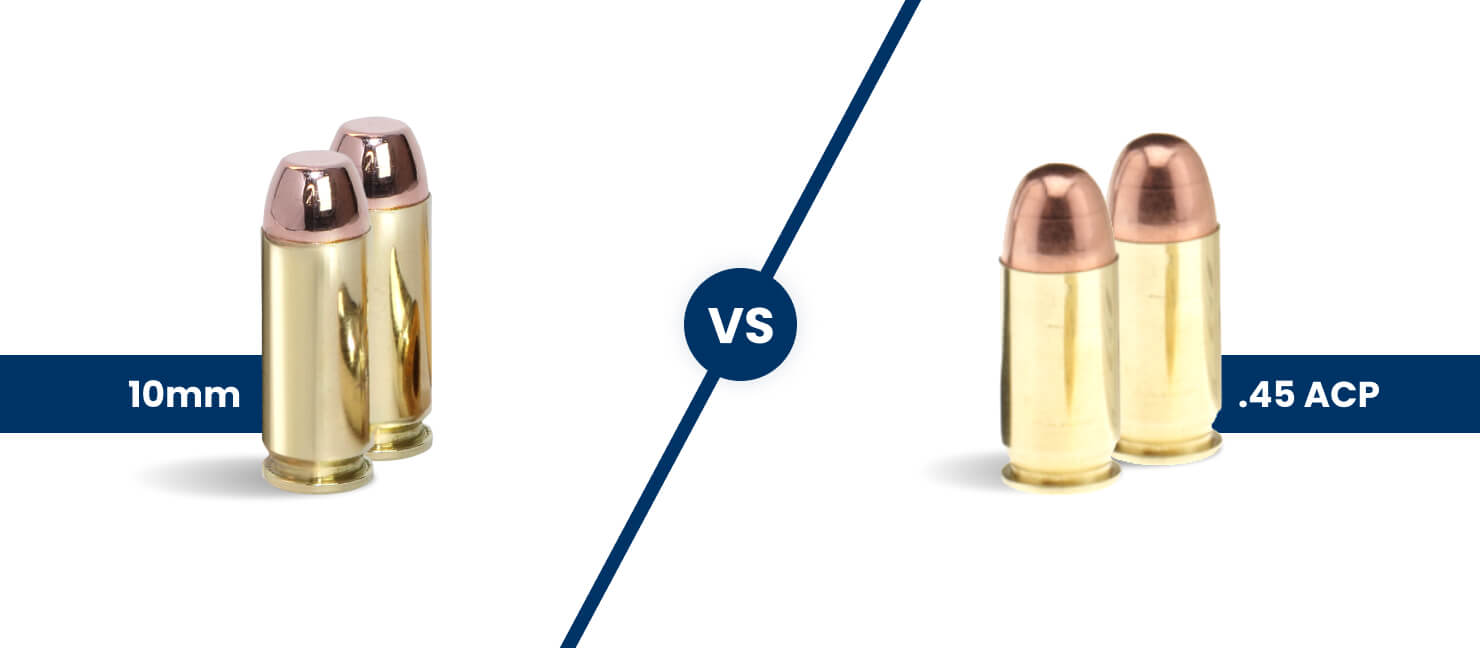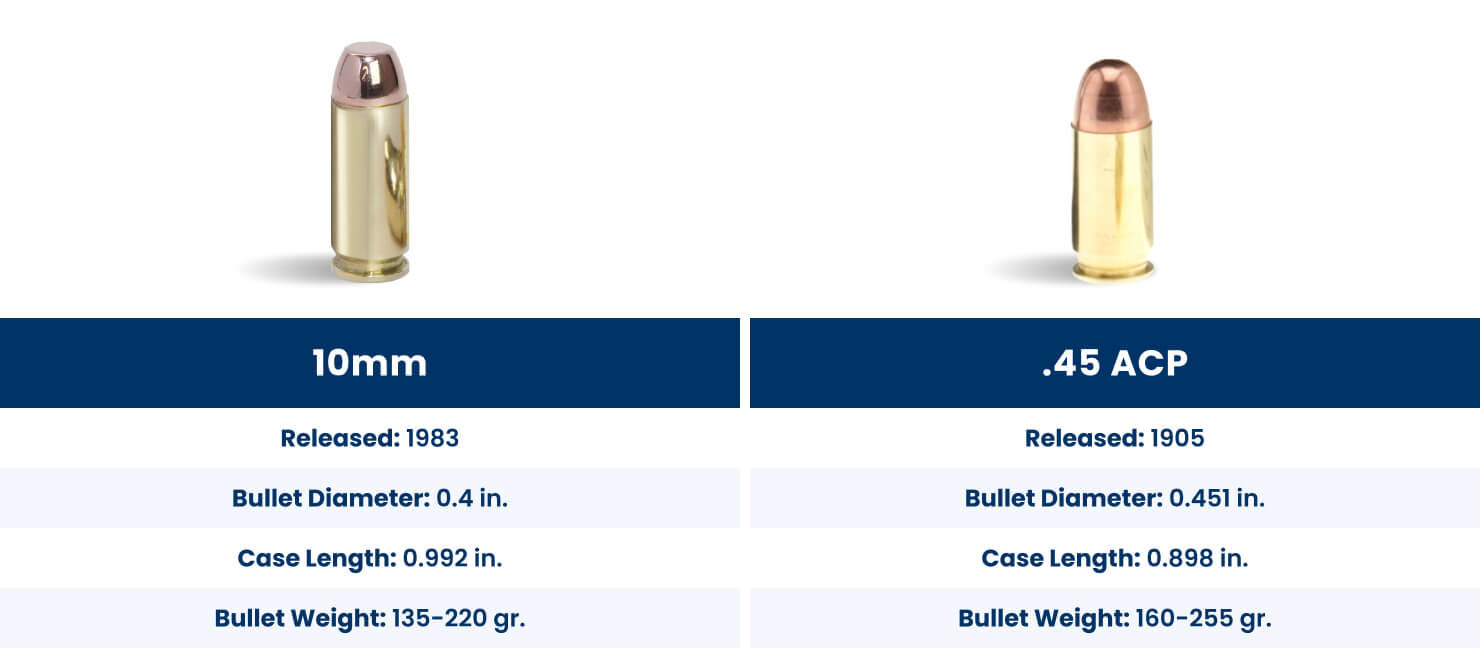.45 ACP vs 10mm: Discover Which Cartridge Is Best

When it comes to semi-automatic pistols for home or self-defense, two of the most commonly compared cartridges are the .45 ACP and the 10mm. Whether you're considering the classic pairing of the .45 ACP with the 1911 or exploring options in GLOCK pistols, each has its pros and cons. Let’s delve into the characteristics of a 10mm vs .45 ACP so you can choose the best firearm for your needs.
Key Takeaways
- 10mm vs .45 ACP: Which Is Better? — The .45 ACP has a larger bullet diameter, less recoil, and more pistol selection, while the 10mm has more power, velocity, and energy.
- .45 vs 10mm: Ballistic Performance — The 10mm is similar to the .357 Magnum and delivers 700 ft-lbs more muzzle energy than the .45 ACP but .45 ACP loads have greater expansion on impact.
- Who Are 10mm and .45 ACP Ammo for? — If you need cheaper ammo and lighter recoil, choose the .45 ACP. If you’re using a pistol for camping or hunting, choose a 10mm for more power.
- .45 vs 10mm: Popular Firearm Options — Glock 20 and Glock 40 are popular firearms for 10mm, while any .45 ACP 1911 pistols are great for the gun range.
10mm vs .45 ACP: Which is Better?
John Moses Browning designed the .45 ACP in 1904, and it has seen action in WWI, WWII, the Korean War, the Vietnam War, and more. Gun enthusiasts favor the .45 ACP because of its more cost-effective ammunition, larger bullet diameter, and stopping power.
Norma developed the 10mm in 1983 with the help of Lt. Col. Jeff Cooper. It offers more power, faster velocity, and energy. It also boasts a slightly higher magazine capacity, accommodating 1-3 additional rounds, and is commonly available in double-stack magazines. Below, we’ll cover bullet specifications such as weight, diameter, and case length.
| 10mm vs 45 ACP: Bullet Specs | ||
|---|---|---|
| Category | 10mm | .45 ACP |
|
135-220 grains |
160-255 grains |
|
|
Bullet Diameter |
0.4 in. |
0.451 in. |
|
Case Diameter |
0.425 in. |
0.473 in. |
|
Case Length |
0.992 in. |
0.898 in. |
|
Overall Length |
1.26 in. |
1.275 in. |
|
Chamber Pressure (SAAMI) |
37,500 psi |
21,000 psi |
|
Case Capacity |
24.1 grains |
26.7 grains |
45 vs 10mm: Ballistic Performance
The 10mm shares power levels akin to the .357 Magnum, boasting a significant energy advantage over the .45 ACP. For example, a 200-grain 10mm round traveling at 1,200 fps can deliver more than 700 ft-lbs of energy upon impact.
The table below covers additional ballistic performance details such as muzzle velocity, bullet drop, and price, offering a comprehensive comparison of these two cartridges.
| 45 vs 10mm: Ballistic Performance | ||
|---|---|---|
| Category | 10mm | .45 ACP |
|
Uses |
Self-defense, hunting, some law enforcement |
Self-defense, military, law enforcement |
|
Price |
$0.70-$2.00 per round |
$0.50-$3.75 per round |
|
Muzzle Velocity |
1,100-1,400 fps |
800-1,000 fps |
|
Muzzle Energy |
500-750 ft-lbs |
350-550 ft-lbs |
|
Bullet Drop |
3-5 in. at 100 yards |
7-10 in. at 100 yards |
|
Recoil |
High |
Moderate |
|
Magazine Capacity |
10-15 rounds |
7-8 rounds |
10mm vs .45 ACP Uses
Both .45 ACP and 10mm find applications in self-defense, military, and law enforcement. See which cartridge is best for situations like concealed-carry and hiking.
- The .45 ACP is a suitable choice for concealed carry due to its substantial stopping power. Law enforcement has also favored the .45 ACP in the past.
- The 10mm shines when power and range are paramount. It's an excellent companion for outdoor activities and offers reliable protection against larger predators. However, it may not be the first choice for home defense due to overpenetration.

10mm vs .45 ACP Price
The .45 ACP offers more cost-effective ammunition options in comparison to the 10mm. The .45 ACP also boasts greater availability of ammunition. Look for brass-cased ammo to keep your gun cleaner and shooting effectively.
- Average .45 ACP ammunition prices tend to be $0.50 to $3.25 per round. This type is usually less expensive and more widely available.
- 10mm ammunition averages between $0.70 to $2.00 per round. Its per-round cost is a bit higher than the .45 ACP.
10mm vs .45 ACP Muzzle Velocity
The 10mm surpasses the .45 ACP in terms of energy output. However, this does come at the cost of increased muzzle rise (jumps or recoils upward after a shot is fired).
- The .45 ACP typically achieves velocities ranging from 800 to 1,000 fps. Low muzzle velocity will increase the bullet drop over a longer distance.
- In contrast, the 10mm boasts velocities between 1,100 and 1,400 fps, signifying a higher muzzle velocity and faster performance. The 10mm is more reliable for long-range shooting.
10mm vs .45 ACP Muzzle Energy
The 10mm cartridge has a higher muzzle energy than the .45 ACP. This additional energy can be advantageous in situations such as hunting large game or self-defense.
- The .45 ACP typically exhibits muzzle energy ranging from 350 to 550 ft-lbs. This makes it a solid choice for self-defense and close-quarters encounters.
- The 10mm boasts a substantial muzzle energy ranging from 500 to 750 ft-lbs. It provides excellent stopping power and penetration capabilities.
10mm vs .45 ACP Bullet Drop
The 10mm has a significantly lower bullet drop when contrasted with the .45 ACP. This results in a much flatter trajectory.
- The .45 ACP experiences a notable 7-10 inches of bullet drop at 100 yards. This makes it better suited for close combat scenarios, with an effective range of around 120 yards.
- The 10mm has a mere 3-5 inches of bullet drop at 100 yards. This makes it ideal for hunting at any distance under 200 yards.
10mm vs .45 ACP Recoil
The 10mm cartridge has a stronger recoil than the .45 ACP. While its recoil may present a challenge for some, mastering it can lead to superior performance in terms of power and accuracy.
- In the case of the .45 ACP, shooters often experience a more manageable recoil, which enables quicker follow-up shots. This attribute makes it a favored choice for those seeking a balance between firepower and control.
- Conversely, the 10mm recoil is notably more assertive. It requires dedicated practice and training to effectively manage and control the firearm.
10mm vs .45 ACP Magazine Capacity
When it comes to magazine capacity, the 10mm outperforms the .45 ACP in terms of the number of rounds it can hold, depending on the firearm size.
- The .45 ACP cartridge has a more limited magazine capacity. It can accommodate 7-8 rounds for most magazines, although some 15-round options may be available.
- The 9mm produces a more mild recoil at 4-8 lbs of force. This is better for beginners learning how to control their shot placement.
Who Are 10mm and .45 ACP Ammo For?
If you're looking for a firearm with abundant ammo availability at a relatively lower cost, the .45 ACP is a suitable choice. It's also a preferred option if you intend to use a suppressor or if you're new to shooting and prefer a firearm with manageable recoil.
On the other hand, if you prioritize power, the 10mm is the way to go. Whether you're hunting, camping, or in need of protection against bears, the 10mm offers superior muzzle velocity, power, and range. Additionally, its slightly higher round capacity may be advantageous for self-defense situations.
10mm Ammo Pros & Cons
The 10mm is a powerful and versatile cartridge, favored by hunters and handgun enthusiasts for its impressive energy and range. However, you should keep in mind that it has heavy recoil and higher ammunition costs.
10mm Ammo Pros
|
10mm Ammo Cons
|
45 ACP Pros & Cons
The .45 ACP is highly reliable and used widely for concealed carry. However, it does have some drawbacks, like limited magazine capacity and higher bullet drop.
.45 ACP Ammo Pros
|
.45 ACP Ammo Cons
|
45 vs 10mm: Popular Firearm Options
- There are several popular options available for the 10mm cartridge, including:
- Some widely used pistols chambered in .45 ACP include the iconic .45 ACP 1911 Pistols. Popular options in this caliber include:
Have Fun Out There!
Ready to try some new cartridges? Whether you’re checking out a different firearm for hunting or self-defense, embrace the power of the 10mm and the reliable protection of the .45 ACP. Both are available at Academy Sports + Outdoors!


